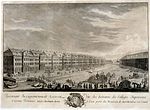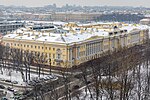Universitetskaya Embankment

Universitetskaya Embankment (Russian: Университетская набережная) is a 1.2 km long embankment on the right bank of the Bolshaya Neva, on Vasilievsky Island in Saint Petersburg, Russia. Starting at the Spit of Vasilievsky Island, it spans between Palace Bridge and Blagoveshchensky Bridge. The bank was lined with granite in 1805–1810 (eastern part), 1831–1834 (western part) and the 1850s (near Blagoveshchensky Bridge). It features an ensemble of Petrine Baroque buildings of the early 18th century, including the Kunstkamera, Twelve Collegia, Menshikov Palace, as well as the neoclassical building of the Academy of Arts. The embankment was formerly connected to the left bank through Isaakiyevsky Pontone Bridge, constructed in 1819–1841 in front of Senate Square. One of the campuses of Saint Petersburg State University (hosted in the Twelve Collegia and several other buildings), Saint Petersburg branch of the Russian Academy of Sciences, Peter the Great Museum of Anthropology and Ethnography (hosted in the Kunstkamera) and Zoological Museum are all situated along the embankment. The embankment was named after the university in 1887.
Excerpt from the Wikipedia article Universitetskaya Embankment (License: CC BY-SA 3.0, Authors, Images).Universitetskaya Embankment
University Embankment, Saint Petersburg
Geographical coordinates (GPS) Address Nearby Places Show on map
Geographical coordinates (GPS)
| Latitude | Longitude |
|---|---|
| N 59.9392 ° | E 30.2984 ° |
Address
Манеж Первого кадетского корпуса
University Embankment 13
199034 Saint Petersburg (округ № 7)
Saint Petersburg, Russia
Open on Google Maps











